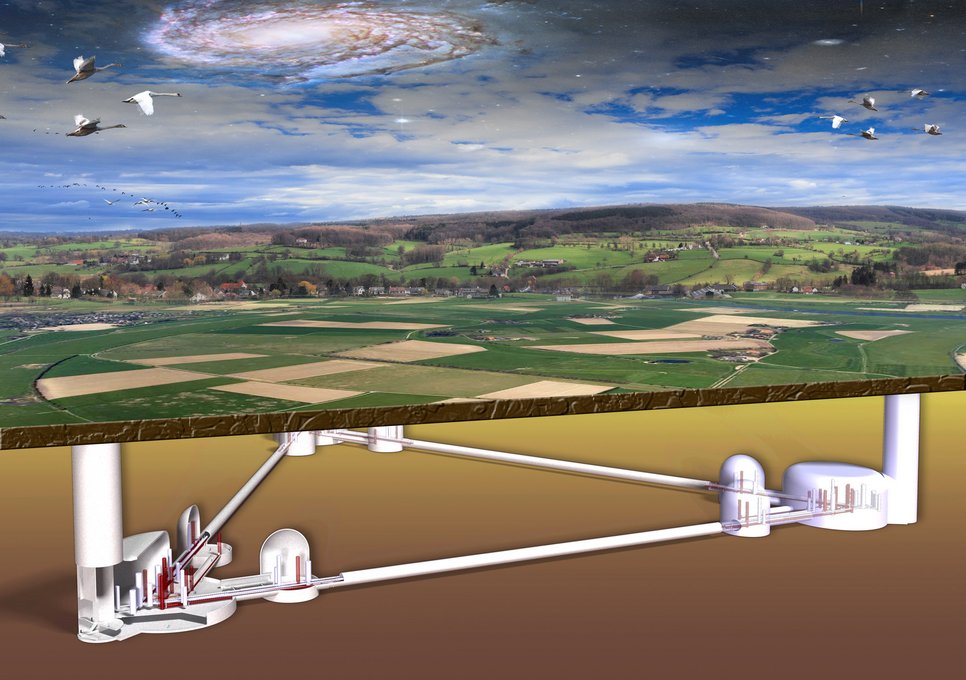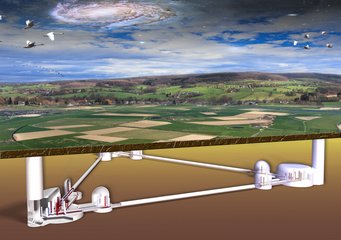European Commission funds design study for unique future observatory
By allocating three million Euro within the FP7 programme for preliminary studies for the Einstein Telescope (ET) – a pan-European gravitational wave observatory – the European Commission has made a decisive step towards the exploration of the universe with gravitational waves. With this grant, the commission confirms the importance of gravitational wave research for both basic and applied scientific research in Europe.
“With its decision, the European Commission recognizes the achievements made by the gravitational wave observatories GEO600 and Virgo, and paves the way for the development of the first pan-European gravitational wave detector”, says Jacques Colas, director of the European Gravitational Observatory (EGO) and project coordinator of the design study for the Einstein Telescope. The Einstein Telescope is one of the 'Magnificent Seven' European projects recommended by the ASPERA network for the future development of astroparticle physics in Europe.
The direct detection of gravitational waves – tiny distortions of space-time predicted by Albert Einstein - is one of the most important and fundamental research areas of modern science. Their direct observation will allow us totally new insights into our universe inaccessible to any other technology – including clues as to its very beginning.
The Einstein Telescope Project (ET)

ET is a joint project of eight European research institutes, under the direction of EGO. The participants are EGO, an Italian French consortium located near Pisa (Italy), Istituto Nazionale di Fisica Nucleare (INFN) from Italy, the French Centre National de la Recherche Scientifique (CNRS), the German Albert Einstein Institute (AEI) Hannover, the Universities of Birmingham, Cardiff and Glasgow from United Kingdom and the Dutch Vrije Universiteit Amsterdam.
The funds granted now by the European Commission will be used in a design study for ET over the next three years. The design study is an important step towards the third generation of gravitational wave observatories, defining the specifications for the required site and infrastructure and the necessary technologies, and lastly also the total budget needed.
Michele Punturo, scientific coordinator of the Einstein Telescope design study: „The first two generations will already launch the age of gravitational wave astronomy, and we expect this third generation observatory to be a hundred times more sensitive than current detectors. The observable volume of the universe will increase by a factor of a million.” Additionally all frequencies that can be measured on Earth, the entire range between 1 Hz and 10 kHz, should be detected by this instrument. “This allows ET to open a new door in gravitational wave research”, says Punturo. The ambitious goal will be reached by combining the cutting edge of all currently known technologies in a single observatory.
Harald Lück, deputy scientific coordinator of the ET Design Study and coordinator of the upgrade of the GEO600 detector adds: “The European experimental gravitational wave research community presents a well consolidated development plan, which is synchronized with the US plans, from the current observatories and the second generation interferometers - scheduled to take data in a few years - to the Einstein Telescope project.”
“Observation of gravitational waves would have far-reaching consequences, aside from verifying the General Theory of Relativity: It would become possible to cast an eye on the “early childhood” of our universe for the first time,” says Harald Lück. Up to now observation of the sky is limited to the electromagnetic spectrum (e.g., radio and X-ray telescopes and astronomy in visible light) and observation of cosmic rays and neutrinos. The information thus available to us can reach us from the past only from a time at least 380,000 years after the Big Bang. Epochs dating back further have thus far remained hidden, as the universe became transparent for electromagnetic radiation only at that time. The various theories on the early universe have therefore remained unverified experimentally. The direct measurement of gravitational waves may allow “listening” back as far as the very first trillionth of a second following the Big Bang: This would give us totally new information about our universe: with gravitational wave astronomy, totally new areas of science will become accessible.
The global network
Gravitational wave research is a global effort because the full information about many gravitational wave sources can only be obtained with several interferometers working simultaneously in different places. Therefore the US, German-British, Italian-French, and Dutch scientific communities have been working together closely for a long time. They share technology development, numerical relativity methods and data analysis methods and tools. The joint European project ET will help to further improve this world wide collaboration.
Status of current detectors
Currently, several first generation gravitational wave detectors are active in Europe. The German-British GEO600 observatory, funded by STFC (Science and Technology Facilities Council) and MPG (Max Planck Gesellschaft), is operating close to Hanover while the French-Italian-Dutch Virgo project is located in Cascina near Pisa (Italy). These interferometers pool their data with the three American LIGO interferometers and are currently doing extensive searches for gravitational waves from astrophysical systems.
Searches for gravitational waves from these data sets and the algorithms used in the analysis are the result of many years of research and development in Europe and the U.S. Today European scientists are leading several of the analyses efforts in this international pursuit for the direct detection of gravitational waves.
During the next decade all interferometric gravitational wave detectors will be upgraded to second-generation instruments. Virgo and LIGO will gain a factor of about ten in sensitivity at lower frequencies (up to about a kilohertz) using technology developed in Europe and elsewhere. GEO will pioneer high frequency wide-band observing above one kilohertz, again deploying new technologies. If the current instruments do not make the first detections of gravitational waves, it can confidently be expected that this will be done by the second-generation interferometers.
The ET project fits well into this scenario. In fact, after the completion of the design study and of a subsequent technical preparation phase, the effective construction could begin, probably in the year 2017 or 2018, after the second generation observatories have started operating.
The technology required for third generation detectors is being studied in several countries besides Europe, including the USA and Japan. All third-generation detectors that are eventually built will need to perform joint observations together (as the previous generation detectors do).
